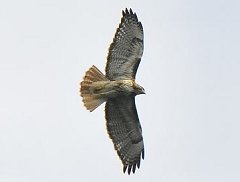
Sumas Mountain is located at the eastern end of Abbotsford and parts of it is designated regional park. Most of this site guide covers the eastern part of the mountain.
The first parking location is just inside the main gate at the end of Batt Road. Parking here and walking south up a deactivated logging road provides a nice walk and some hawkwatching opportunity. Between the lower parking lot and the upper parking lot located at the Western Viewpoint is about 5 km of road. Birding is good along here and the side roads offer lots to explore. From the Western Viewpoint parking lot the park's trails begin which offer access to Chadsey Lake or the Eastern Viewpoint which overlooks Chilliwack. The Western Viewpoint offers the best hawkwatching as well. A gate, which is always closed, is found about 200 meters past the Western Viewpoint parking lot.
Amenities include pit toilets at the Lower Viewpoint and Western Viewpoint parking lots. More information on the park and gate opening and closing times visit the FVRD website.
Birds
Spring brings a healthy assortment of migrants of warblers, flycatchers and vireos. Focusing on the younger stands of trees will provide the best birding. Try some of the side roads or the trail to the Lower Viewpoint. Hermit Thrush are annual nesters at the highest point on Sumas Mountain. Look for them around the Eastern Lookout while enjoying views of Chilliwack and the Cheam Mountain Range.
A good number of birds use the site for breeding. MacGillvray’s, Wilson’s, Orange-crowned and Townsend’s Warblers are the most common in their respective habitat types. Hammond’s and Pacific-slope Flycatchers can be counted on to be quite vocal during much of the summer. A hike down to Chadsey Lake will be a sure way to encounter these birds. Red-breasted Sapsucker are also common and both Ruffed and Sooty Grouse are possible.
Fall migration is just as good as spring migration at this site however the added bonus of raptor migration increases the interest. The Western Viewpoint, accessible by car, appears to be the best option. However, the lower viewing area shows promise especially if one does not want to drive the road up to the upper viewpoint. Hawkwatching needs not be overly strenuous. Bring a lawn chair and orient yourself to the north and let the birds come to you. Cooper’s, Sharp-shinned and Red-tailed Hawk are the most common and during peak times in early September dozens can pass in an hour. Bald Eagle, Osprey, Northern Harrier, Merlin and a surprise Prairie Falcon have also been documented.
Winter the area gets fairly quiet but the Red Crossbills, found all year long here continue to be reliable. Varied Thrush, Red-breasted Nuthatch, and Dark-eyed Junco will be kicking around. Northern Pygmy-Owl, which likely breeds at the site, seems to be most detectable late winter when calling more regularly. Due to snow, the upper half of the mountain is often inaccessible.

~By Jamie Gadsden - August 31, 2018
|